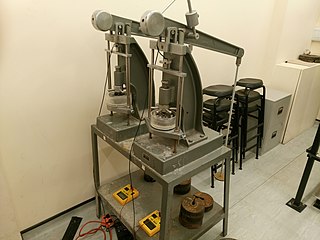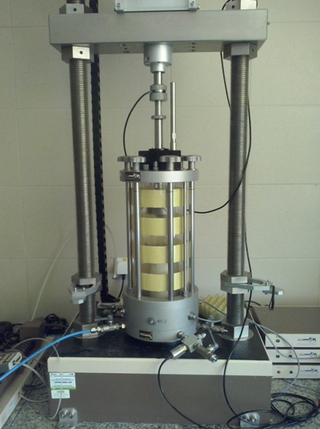Related Research Articles

In continuum mechanics, stress is a physical quantity that describes forces present during deformation. For example, an object being pulled apart, such as a stretched elastic band, is subject to tensile stress and may undergo elongation. An object being pushed together, such as a crumpled sponge, is subject to compressive stress and may undergo shortening. The greater the force and the smaller the cross-sectional area of the body on which it acts, the greater the stress. Stress has dimension of force per area, with SI units of newtons per square meter (N/m2) or pascal (Pa).
In physics and materials science, elasticity is the ability of a body to resist a distorting influence and to return to its original size and shape when that influence or force is removed. Solid objects will deform when adequate loads are applied to them; if the material is elastic, the object will return to its initial shape and size after removal. This is in contrast to plasticity, in which the object fails to do so and instead remains in its deformed state.
Solid mechanics is the branch of continuum mechanics that studies the behavior of solid materials, especially their motion and deformation under the action of forces, temperature changes, phase changes, and other external or internal agents.
Permeability in fluid mechanics and the Earth sciences is a measure of the ability of a porous material to allow fluids to pass through it.

In materials science, a porous medium or a porous material is a material containing pores (voids). The skeletal portion of the material is often called the "matrix" or "frame". The pores are typically filled with a fluid. The skeletal material is usually a solid, but structures like foams are often also usefully analyzed using concept of porous media.

Soil mechanics is a branch of soil physics and applied mechanics that describes the behavior of soils. It differs from fluid mechanics and solid mechanics in the sense that soils consist of a heterogeneous mixture of fluids and particles but soil may also contain organic solids and other matter. Along with rock mechanics, soil mechanics provides the theoretical basis for analysis in geotechnical engineering, a subdiscipline of civil engineering, and engineering geology, a subdiscipline of geology. Soil mechanics is used to analyze the deformations of and flow of fluids within natural and man-made structures that are supported on or made of soil, or structures that are buried in soils. Example applications are building and bridge foundations, retaining walls, dams, and buried pipeline systems. Principles of soil mechanics are also used in related disciplines such as geophysical engineering, coastal engineering, agricultural engineering, hydrology and soil physics.
Poromechanics is a branch of physics and specifically continuum mechanics and acoustics that studies the behaviour of fluid-saturated porous media. A porous medium or a porous material is a solid referred to as matrix) permeated by an interconnected network of pores (voids) filled with a fluid. Usually both solid matrix and the pore network, or pore space, are assumed to be continuous, so as to form two interpenetrating continua such as in a sponge. Natural substances including rocks, soils, biological tissues including heart and cancellous bone, and man-made materials such as foams and ceramics can be considered as porous media. Porous media whose solid matrix is elastic and the fluid is viscous are called poroelastic. A poroelastic medium is characterised by its porosity, permeability as well as the properties of its constituents. The distribution of pores across multiple scales as well as the pressure of the fluid with which they are filled give rise to distinct elastic behaviour of the bulk.
Maurice Anthony Biot was a Belgian-American applied physicist. He made contributions in thermodynamics, aeronautics, geophysics, earthquake engineering, and electromagnetism. Particularly, he was accredited as the founder of the theory of poroelasticity.

The effective stress can be defined as the stress, depending on the applied tension and pore pressure , which controls the strain or strength behaviour of soil and rock for whatever pore pressure value or, in other terms, the stress which applied over a dry porous body provides the same strain or strength behaviour which is observed at ≠ 0. In the case of granular media it can be viewed as a force that keeps a collection of particles rigid. Usually this applies to sand, soil, or gravel, as well as every kind of rock and several other porous materials such as concrete, metal powders, biological tissues etc. The usefulness of an appropriate ESP formulation consists in allowing to assess the behaviour of a porous body for whatever pore pressure value on the basis of experiments involving dry samples.

Soil consolidation refers to the mechanical process by which soil changes volume gradually in response to a change in pressure. This happens because soil is a two-phase material, comprising soil grains and pore fluid, usually groundwater. When soil saturated with water is subjected to an increase in pressure, the high volumetric stiffness of water compared to the soil matrix means that the water initially absorbs all the change in pressure without changing volume, creating excess pore water pressure. As water diffuses away from regions of high pressure due to seepage, the soil matrix gradually takes up the pressure change and shrinks in volume. The theoretical framework of consolidation is therefore closely related to the concept of effective stress, and hydraulic conductivity. The early theoretical modern models were proposed one century ago, according to two different approaches, by Karl Terzaghi and Paul Fillunger. The Terzaghi’s model is currently the most utilized in engineering practice and is based on the diffusion equation.
Applied mechanics is the branch of science concerned with the motion of any substance that can be experienced or perceived by humans without the help of instruments. In short, when mechanics concepts surpass being theoretical and are applied and executed, general mechanics becomes applied mechanics. It is this stark difference that makes applied mechanics an essential understanding for practical everyday life. It has numerous applications in a wide variety of fields and disciplines, including but not limited to structural engineering, astronomy, oceanography, meteorology, hydraulics, mechanical engineering, aerospace engineering, nanotechnology, structural design, earthquake engineering, fluid dynamics, planetary sciences, and other life sciences. Connecting research between numerous disciplines, applied mechanics plays an important role in both science and engineering.

A shear band is a narrow zone of intense shearing strain, usually of plastic nature, developing during severe deformation of ductile materials. As an example, a soil specimen is shown in Fig. 1, after an axialsymmetric compression test. Initially the sample was cylindrical in shape and, since symmetry was tried to be preserved during the test, the cylindrical shape was maintained for a while during the test and the deformation was homogeneous, but at extreme loading two X-shaped shear bands had formed and the subsequent deformation was strongly localized.

A triaxial shear test is a common method to measure the mechanical properties of many deformable solids, especially soil and rock, and other granular materials or powders. There are several variations on the test.

Shear strength is a term used in soil mechanics to describe the magnitude of the shear stress that a soil can sustain. The shear resistance of soil is a result of friction and interlocking of particles, and possibly cementation or bonding of particle contacts. Due to interlocking, particulate material may expand or contract in volume as it is subject to shear strains. If soil expands its volume, the density of particles will decrease and the strength will decrease; in this case, the peak strength would be followed by a reduction of shear stress. The stress-strain relationship levels off when the material stops expanding or contracting, and when interparticle bonds are broken. The theoretical state at which the shear stress and density remain constant while the shear strain increases may be called the critical state, steady state, or residual strength.
Terzaghi's Principle states that when stress is applied to a porous material, it is opposed by the fluid pressure filling the pores in the material.
Porosity or void fraction is a measure of the void spaces in a material, and is a fraction of the volume of voids over the total volume, between 0 and 1, or as a percentage between 0% and 100%. Strictly speaking, some tests measure the "accessible void", the total amount of void space accessible from the surface.
Gassmann's equations are a set of two equations describing the isotropic elastic constants of an ensemble consisting of an isotropic, homogeneous porous medium with a fully connected pore space, saturated by a compressible fluid at pressure equilibrium.
Infrasonic passive seismic spectroscopy (IPSS) is a passive seismic low frequency technique used for mapping potential oil and gas hydrocarbon accumulations.
John W. Rudnicki is an American engineering professor.

Pore structure is a common term employed to characterize the porosity, pore size, pore size distribution, and pore morphology of a porous medium. Pores are the openings in the surfaces impermeable porous matrix which gases, liquids, or even foreign microscopic particles can inhabit them. The pore structure and fluid flow in porous media are intimately related.
References
- ↑ M.Liu et al. Multiscale modeling of effective elastic properties of fluid-filled porous materials International Journal of Solids and Structures (2019) 162, 36-44
- 1 2 Biot MA (1941-02-01). "General Theory of Three‐Dimensional Consolidation". Journal of Applied Physics. 12 (2): 155–164. Bibcode:1941JAP....12..155B. doi:10.1063/1.1712886. ISSN 0021-8979.
- ↑ Cheng AH (2016). Poroelasticity. Theory and Applications of Transport in Porous Media. Vol. 27. Springer. doi:10.1007/978-3-319-25202-5. ISBN 978-3-319-25200-1. S2CID 240649873.
- ↑ Wang HF (2000). Theory of linear poroelasticity with applications to geomechanics and hydrogeology. Princeton University Press.
- ↑ Cowin SC (1999). "Bone poroelasticity". Journal of Biomechanics. 32 (3): 217–38. doi:10.1016/s0021-9290(98)00161-4. PMID 10093022.
- ↑ Malandrino, Andrea; Moeendarbary, Emad (2019), "Poroelasticity of Living Tissues", in Narayan, Roger (ed.), Encyclopedia of Biomedical Engineering, Oxford: Elsevier, pp. 238–245, doi:10.1016/B978-0-12-801238-3.99932-X, ISBN 978-0-12-805144-3, S2CID 186300583 https://www.researchgate.net/publication/321986395_Poroelasticity_of_Living_Tissues
- ↑ Moeendarbary E, Valon L, Fritzsche M, Harris AR, Moulding DA, Thrasher AJ, Stride E, Mahadevan L, Charras GT (March 2013). "The cytoplasm of living cells behaves as a poroelastic material" (PDF). Nature Materials. 12 (3): 253–61. Bibcode:2013NatMa..12..253M. doi:10.1038/nmat3517. PMC 3925878 . PMID 23291707.
- ↑ Dormieux L, Kondo D, Ulm F (2006). Microporomechanics. Wiley. doi:10.1002/0470032006. ISBN 9780470032008.
- ↑ Cowin SC, Doty SB, eds. (2007). Tissue Mechanics. Springer. doi:10.1007/978-0-387-49985-7. ISBN 978-0-387-36825-2.
- ↑ Zoback, Mark D.; Kohli, Arjun H. (2019). Unconventional Reservoir Geomechanics: Shale Gas, Tight Oil, and Induced Seismicity. Cambridge: Cambridge University Press. doi:10.1017/9781316091869. ISBN 978-1-107-08707-1. S2CID 197568886.
- ↑ Saurabh, Suman; Harpalani, Satya (2018-01-01). "The effective stress law for stress-sensitive transversely isotropic rocks". International Journal of Rock Mechanics and Mining Sciences. 101: 69–77. doi:10.1016/j.ijrmms.2017.11.015. ISSN 1365-1609.
- ↑ Liu, Zhen (Leo). "Multiphysics - Poroelasticity and Poromechanics". www.multiphysics.us. Retrieved 2018-10-03.
- ↑ Zhen (Leo) Liu (2018). Multiphysics in Porous Materials. Springer. ISBN 9783319930275.
- ↑ Biot, M. A. (April 1962). "Mechanics of Deformation and Acoustic Propagation in Porous Media" (PDF). Journal of Applied Physics. 33 (4): 1482–1498. Bibcode:1962JAP....33.1482B. doi:10.1063/1.1728759. ISSN 0021-8979. S2CID 58914453.
- ↑ Biot, M. A. (March 1956). "Theory of Propagation of Elastic Waves in a Fluid‐Saturated Porous Solid. II. Higher Frequency Range" (PDF). The Journal of the Acoustical Society of America. 28 (2): 179–191. Bibcode:1956ASAJ...28..179B. doi:10.1121/1.1908241. ISSN 0001-4966.